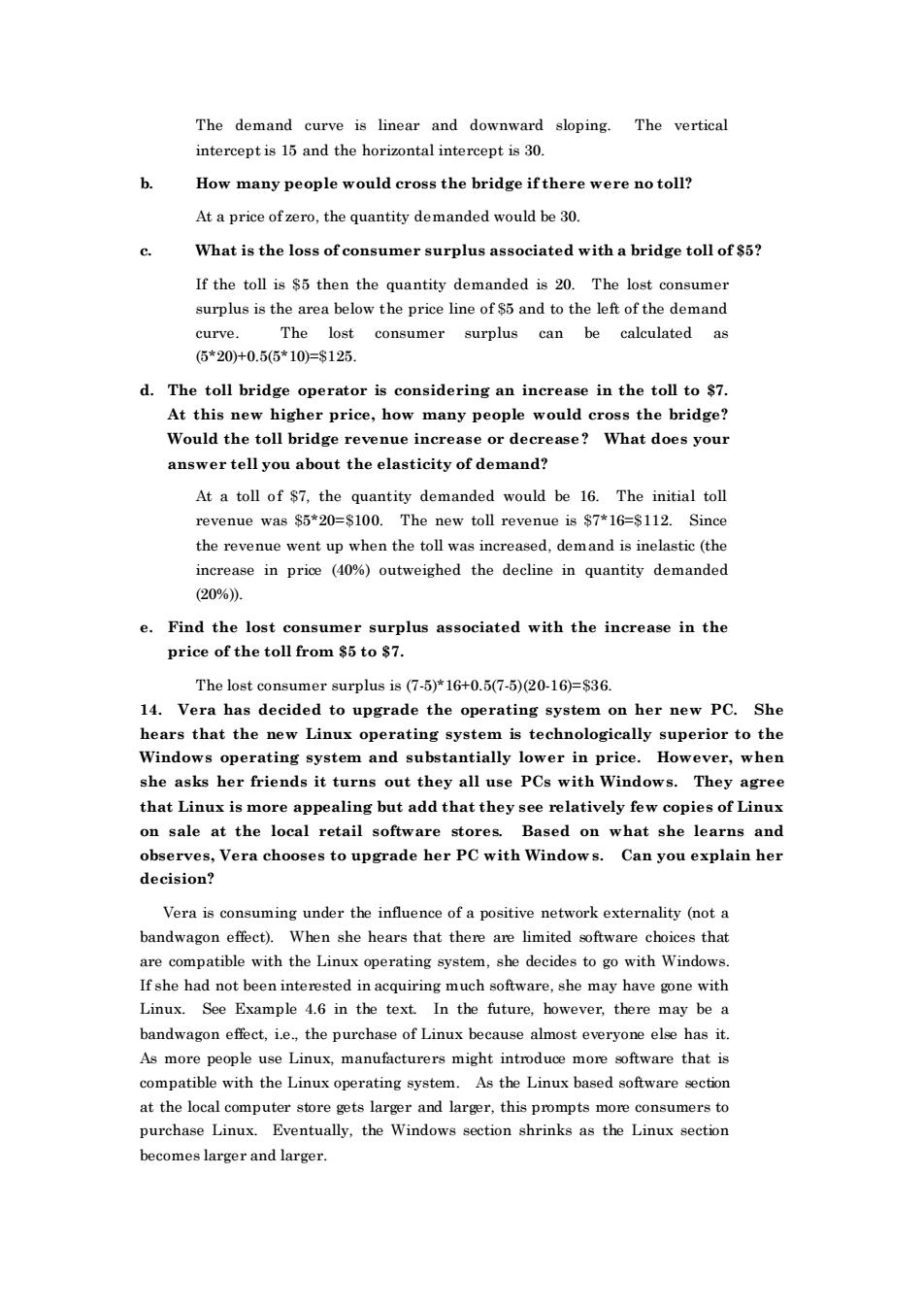正在加载图片...

The demand curve is linear and downward sloping.The vertical interceptis15 and the horizontal interceptis30. b. How many people would cross the bridge if there were no toll? At a price ofzero,the quantity demanded would be 30. What is the loss of consumer surplus associated with a bridge toll of$5? If the toll is s5 then the quantity demanded is 20.The lost consume surplus is the area below the price line of $5 and to the left of the demand curve. The lost consumer surplus can be calculated as (5*20)+0.5(5*10=8125. d.The toll bridge operator is considering an increase in the toll to $7. At this new higher price,how many pec ople would cross the bridge? Would the toll bridge venue increas or decrease?What does you answer tell you about the elasticity of demand? At a toll of $7,the quantity demanded would be 16.The initial toll revenue was $5*20=$100.The new toll revenue is $7*16=$112.Since the revenue went up when the toll was increased,demand is inelastic (the increase in price (40%)outweighed the decline in quantity demanded 20%. e.Find the lost cor r su rplus associated with the increase in the price of the toll from $5 to $7. The lost consumer surplus is (7-5)*16+0.5(7-5)(20-16)=$36 14.Vera has decided to upgrade the operating system on her new PC.She hears that the new Linux operating system is technologically superior to the Windows operating system and substantially lower in price.However,when she asks her friends it turns out they all use PCs with Windows.They agree that Linux is more appealing but add that they see relatively few copies of Linus on sale at the local retail software stores.Based on what she learns and observes,Vera chooses to upgrade her PC with Windows.Can you explain her decision? Vera is consuming under the influence of a positive network externality(not a bandwagon effect).When she hears that there are compatible with the Lin nux operating system,sh to go with Windows If she had not been interested in acquiring much software,she may have gone with Linux.See Example 4.6 in the text.In the future,bowever,there may be a bandwagon effect,ie,the purchase of Linux because almost everyone else has it. peopleLinuxmanufacturersmight introducmore with the Linux operating syster As the Linux based software ection at the local computer store gets larger and larger,this prompts more consumers to purchase Linux.Eventually,the Windows section shrinks as the Linux section becomes larger and larger. The demand curve is linear and downward sloping. The vertical intercept is 15 and the horizontal intercept is 30. b. How many people would cross the bridge if there were no toll? At a price of zero, the quantity demanded would be 30. c. What is the loss of consumer surplus associated with a bridge toll of $5? If the toll is $5 then the quantity demanded is 20. The lost consumer surplus is the area below the price line of $5 and to the left of the demand curve. The lost consumer surplus can be calculated as (5*20)+0.5(5*10)=$125. d. The toll bridge operator is considering an increase in the toll to $7. At this new higher price, how many people would cross the bridge? Would the toll bridge revenue increase or decrease? What does your answer tell you about the elasticity of demand? At a toll of $7, the quantity demanded would be 16. The initial toll revenue was $5*20=$100. The new toll revenue is $7*16=$112. Since the revenue went up when the toll was increased, demand is inelastic (the increase in price (40%) outweighed the decline in quantity demanded (20%)). e. Find the lost consumer surplus associated with the increase in the price of the toll from $5 to $7. The lost consumer surplus is (7-5)*16+0.5(7-5)(20-16)=$36. 14. Vera has decided to upgrade the operating system on her new PC. She hears that the new Linux operating system is technologically superior to the Windows operating system and substantially lower in price. However, when she asks her friends it turns out they all use PCs with Windows. They agree that Linux is more appealing but add that they see relatively few copies of Linux on sale at the local retail software stores. Based on what she learns and observes, Vera chooses to upgrade her PC with Windows. Can you explain her decision? Vera is consuming under the influence of a positive network externality (not a bandwagon effect). When she hears that there are limited software choices that are compatible with the Linux operating system, she decides to go with Windows. If she had not been interested in acquiring much software, she may have gone with Linux. See Example 4.6 in the text. In the future, however, there may be a bandwagon effect, i.e., the purchase of Linux because almost everyone else has it. As more people use Linux, manufacturers might introduce more software that is compatible with the Linux operating system. As the Linux based software section at the local computer store gets larger and larger, this prompts more consumers to purchase Linux. Eventually, the Windows section shrinks as the Linux section becomes larger and larger